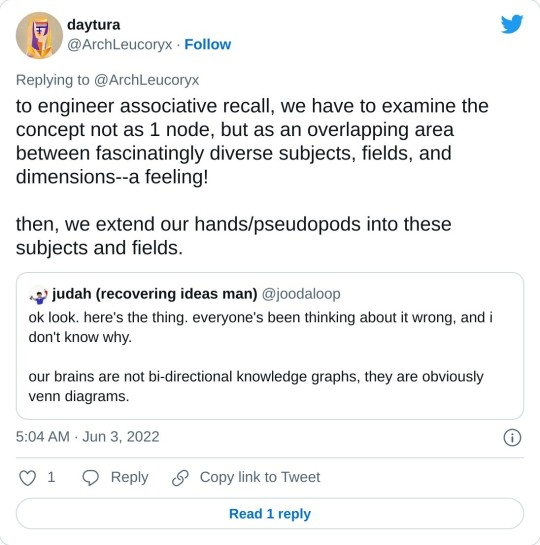#subtle hints of lilypad
Text
Page-title-tag unity: A mechanism for digital associative recall
Tentative name.
Page-title-tag unity evolved from my older, simpler idea of page-tag duality, where each tag is/opens to it's own page, and each page is/can be referenced as it's own tag. Page-tags could be used as a page, as a tag, or both. I arrived at page-tags from observing the emergent structure of my RADA project on my old blog, where readers could "lilypad" across the loose jumble of notes at their own pace and control.
However, page-tags were too simple. Although applications like Logseq, Roam, and Exegenesis do have page-tag duality per their querying systems, it was not the elegant unity that I experienced with RADA. It would've been more accurate to say that my lilypadding was closer to a wikilink-tag duality (namely, writing in-line wikilinks in the below tags section of each post), with the associative recall and navigation emerging as a side effect.
Today, PTT accurately defines the mechanics of this tag-based lilypadding without the need for direct wikilinking features. In any given folder of notes:
Each page has a title.
Each title references a page.
Each title can be written and used as a tag.
Each title-tag references a page.
Title-tags can be appended and/or attached to other pages.
In sum, each title-tag is a soft reference/vector to that page.
The effects of PTT unity emerge with messiness and scale. By the simple work of adding ostensibly extraneous tags to single pages or notes (whether these title-tags are written in the text or not, leaving some elbow room up to the user), we can make higher associations while simultaneously enriching the original, in-person idea hinted by the tag-title and it's page. This means that each note associated to the original note is as much a native part of the text as the original text was. More simply, every referenced page-tag-title becomes part of the note, almost like it was part of the note to begin with. (This completely solves the problem of context in networked note-taking.)
PTT unity also satisfies the indexical nature of classic wikilinks, where the process of putting double brackets around the most important general concepts of the database (e.g. "shame", "antifragility") actually defines these concepts through the linked and unlinked references. This organic index becomes closer to a personal distributed glossary, where every concept begets detailed perspectives and subtle patterns. There is technically nothing stopping the user from tagging general concepts and aggregating masses of notes per tag, though they will have to reckon with the rapid inflation of text given that each note will be displayed in full.
Theory aside, PTT unity has the potential to supplant [[sequence-branch duality]] as an actual mechanic and not just an example for the PKM null theory. Again, sequence-branch duality tells us that we can read all radially branching linked notes in a linear sequence, and we can read all linear sequences as equal radial branches of a more fundamental topic or synthetic idea. In form, sequence-branch duality demonstrates that the arrangement of the notes does not matter so much their proximity does; this gives power back to the reader, and their navigation abilities as they explore the network.
Knowing that PTT unity literally appends/groups all referenced notes to the original note as a larger, developing topic, PTT immediately supercharges sequence-branch duality. If we can read all radially branching notes in a linear sequence, why not put those notes side-by-side or at the bottom of the original note? Further, if we can read all sequential notes as radial branches from a deeper or more synthetic idea, why not tag the entire sequence with that deeper idea and dissolve the linearity more readily?
If sequence-branch duality conjectures that many organizational structures are interchangeable and arbitrary, PTT unity executes it. Indeed, this is the raw power of associations. Associations are not direct links between two single points. Rather, they are (closer to) hypergraphs and overlapping regions between fuzzy categories. After all, we use ideas more than we really define them. By unlocking more accurate associations, we can better cut across specific experiences and information more external to ourselves, and generalize novel observations that can then be inspired and synthesized for our own purposes.

---
See also:
[[Reinventing monism with the topological razor]]




#postrox#homegrown by postie#associative memory#digital recall#memory#associativity#page-title-tag unity#tagging#sequence-branch duality#reinventing monism with the topological razor
0 notes